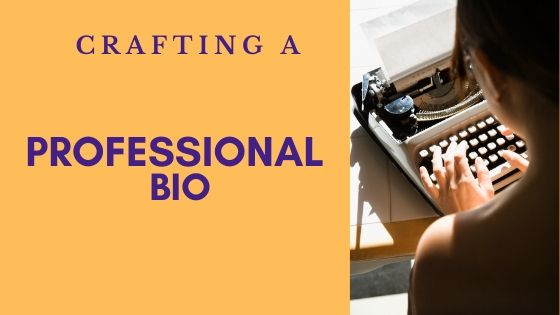October 24, 2019

When you are asked for your professional bio, the conversation often goes like this:
“Can you email me your professional bio?
“Sure, I’ll get it to you by the end of the day.”
Then panic sets in because you don’t have a bio. So, you scramble to assemble a quick and dirty career summary that probably doesn’t put your best foot forward.
A professional bio is one of the most important tools you can create to build your personal brand. It’s typically needed for a company website, a listing in a professional directory, speaking engagements or articles or blog posts that you write.
And, depending on the platform—social media, conference, website–the length and tone of a bio may vary. For this reason, it’s helpful to have different versions of your bio ready for different platforms. For example: your Twitter bio has to be very short due to character limitations, but your LinkedIn bio, or your summary, can be longer. If you have a personal website, your bio should be thorough and comprehensive (500 words at a minimum). And remember to consider the bio’s tone on each platform. It should be targeted to each audience and context, e.g., a bio on a blog may be more casual than a bio on a corporate website.
A bio is not a resume. A bio is a short narrative story of your professional life. It showcases your experiences and touts your accomplishments. Bios should be crisp, concise, and carefully written to draw in the reader so they want to find out more about you. In contrast, a resume is a more formal, bulleted list of accountabilities and outcomes of your work aimed at a specific job or career objective. It tells a potential employer why you are the right applicant for a particular position and why you deserve an interview.
YOUR BIO IS A STORY, NOT A CHECKLIST
Your bio should go above and beyond your job duties and get to the core of who you are and what you’re about.
As you write your bio, ask yourself:
HIGHLIGHT MAJOR CAREER MILESTONES
Most professionals have a hard time deciding what is important to put into a bio. Highlight career accomplishments you are most proud of and leave out the rest. Think about your formal and information credentials. For instance, your formal credentials include degrees, certificates and job titles, while your information credentials refer to life experiences that have positioned you as an expert in your field. Think of your bio as a story and present interesting nuggets about yourself and let your personality shine.
SHOWCASE YOUR THOUGHT LEADERSHIP
Have you been featured in any national publications or television shows? Include media outlets that featured you. Also include any books, research, papers or articles you have presented or published (as the sole author or as a contributor) and list any industry and community awards.
WHERE TO START?
First paragraph: Begin with your name, title, who you help and how you help them. Your most important details should go in the first sentence. For instance, in my own bio, I start it like this:
LaNella Hooper-Williams is president of Hooper Williams Communications, a strategic communications firm….
Second paragraph: Describe what you do in your current role. Paint a picture of who you are and what you have to offer. Include key accomplishments.
Third paragraph: Add any relevant previous experiences and any key brands you are associated with.
Fourth paragraph: Include certifications, accolades, thought leadership experiences.
Fifth paragraph: Insert degrees and area of study, include university, and any board or committee affiliations.
Also, incorporate relatable facts that reflect your life outside of work, e.g., you may mention your family, hometown, hobbies, interests, etc.
Share Your Contact Information
Include the most direct method for connecting with you at the end of your bio. This could be your email address or a link to your LinkedIn account.
Keep Your Bio Current
Regularly update your bios with new milestones in your career, and periodically check that all of your links still work.
View the sample bio I use for business development.